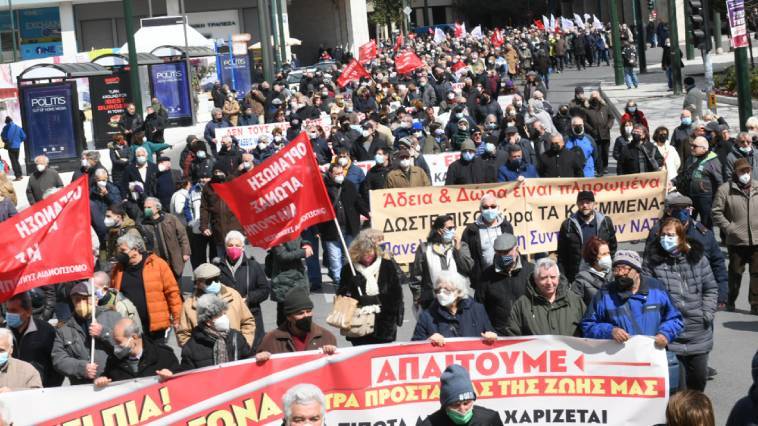
Nightmarish prospects for future retirees. Self-employed workers and farmers, not all of whom belong to the relatively privileged categories of doctors or businessmen, tens of thousands of whom are barely surviving, will face new increases within two months. Many of them are already unable to cope with the 9.6% increase in contributions in 2023, while EFKA’s debt has reached a staggering €46 billion, some 30 billion of which are essentially unrecoverable receivables. The next increase is likely to be 4%.
This increase is due to the tax amendment, which was issued in 2020. Since then, the law has linked the tax to inflation and the consumer price index. Starting in 2025, the change in insurance categories will be determined by Wage change index, which will then be announced by ELSTAT, unless the law changes again. We cannot know at this time whether the wage change index will “benefit” the insured. But despite the increases in contributions, the insured’s pension is expected to be very low, with the vast majority choosing the lowest rung of the scale.
Meanwhile, of the total debt of 46.55 billion euros, 29.81 billion euros or 64% are debts that originated before 2013 and the state has no hope of collecting them. A large portion of these cases concern large debtors. Specifically, 2,578 debtors owe €11.03 billion or 23.7% of the total debt. Nearly 77% of debtors owe an average of €15,000 each, which is a huge sum cumulatively for the EFKA, but difficult to deal with individually in instalments. Many are already losing their settings. As the figures show, only a very small number of debtors are charged to EFKA, with the number reaching 2.5 million.
What will each category give?
90% of the insured choose the lowest level of insurance, and as of January they will have to pay an additional 10 euros, i.e. 240 instead of the 230 they have paid so far and the 210 euros they have paid in 2022. Supplementary. That is, those who want the insurance and the supplement, and who already pay 42.76 euros per month, will pay 44.59 euros as of January. In total they will give an additional 12 euros per month. As for the one-time contribution, the contribution increases by 1.2 euros, and from 28.51 euros in the first category, it reaches 29.7 euros.
The second insurance category will rise to 288.2 euros from 277.2 euros, the third category to 345.5 euros from 332.2 euros, the fourth insurance category to 415.2 euros from 399.3, the fifth to 497, the 6th from 478.5 euros, and the sixth to 647.5 from 622.6 euros per month today. To all these amounts is added 10 euros per month for the unemployment contribution.
In the special category of new insureds, that is, those who entered the profession for the first time in 2023 and are considered junior for five years, from the 138 euros they give, as of January they will give 143.6 euros per month. As far as farmers are concerned, from the €137.6 per month they now pay for main pension, health and the country house at the lowest level, they will pay €143 per month.
Hunger pensions
But in addition to the difficulty of obtaining at least 3,000 euros per year for insurance at the minimum level, since many of them have low incomes, there is also the question of what exactly these professionals are “buying” for their old age. It is estimated that those who choose the lowest level will receive a pension after 20 years worth just €510 in today’s prices. But even if it is possible to insure someone for 40 continuous years, i.e. from 20 years to 60 years, which is difficult or impossible, he will receive a maximum total amount of 770 euros.
According to statistics, in 2023, 80% of insured people again chose the lowest or first insurance category, paying 240.25 euros per month for main insurance, health and unemployment (230 plus 10 euros for unemployment). If a person pays or takes out insurance in the lowest category for 20 years, as very few people are continuously insured from age 20 until they are 60, they will only be able to receive a pension of €506. This results from the minimum national pension of 384 euros plus the so-called compensatory allowance.
The compensation depends on the number of insurance premiums that the person pays because they correspond to the so-called “profits included in the retirement pension calculation” where the state decided to conduct the correspondence. If someone chooses the cheapest insurance of €230, they will be considered to have a ‘pensionable earnings’ of €775 and if they choose the most expensive category or the sixth category, everything will be calculated on the basis of the theoretical ‘pensionable earnings’ which For this purpose exactly step on the scale, it is considered that 2200 euros per month.
The payout for 20 years of insurance in the cheapest category of 230 euros is only 122 euros, because of the 775 euros that are defined as pensionable earnings and part of which is “owed” to the insured in theory, he would lose the money due for a few years of insurance. Specifically, 775 is multiplied by the replacement rate, which is 15.87% for 20 years, resulting in 122 euros instead of 775. These 122 euros, added to the 384 of the national pension, “make us” 506 euros.
If the same person has worked or been insured for 40 years, the replacement rate is 50%. Then 775 is multiplied by 50% and he “gets” a compensatory pension of 385 euros, which, plus the citizen’s 384, “gets” a total pension of 769 euros. In the highest or sixth category, if someone pays 576 euros a month in insurance premiums, in 20 years of work he will receive a pension of 800 euros and in 40 years 1,646.
In the middle category with a premium of 312 euros per month, with 20 years of insurance, he will receive a pension of 582 euros and with 40 years of insurance, 980 in total. For an average human pension of €1,300, always mixed, it should give either €445 per month for 38 years or €576 for 34 years. We remind you that only those who have been insured for more than 15 years are entitled to receive 384 euros from the national pension.
- The opinions expressed in the text are the personal opinions of the author and do not necessarily reflect the position of SLpress.gr
- Republishing the article from other sites without the permission of SLpress.gr is prohibited. It is allowed to republish the first 2-3 paragraphs with an active link added to read the rest on SLpress.gr. Violators will face legal action.

“Avid problem solver. Extreme social media junkie. Beer buff. Coffee guru. Internet geek. Travel ninja.”





More Stories
Heineken: invests 39 million pounds to open dozens of closed pubs in Britain – Economic Mail
Pensions: Hundreds of thousands of retirees are waiting for a retroactive effect – who are the beneficiaries – Newsbomb – News
The $1.4 billion super deal with LVMH and the route from Milan around the world (photos)